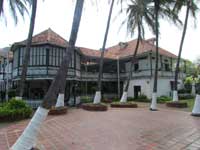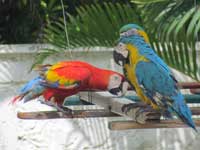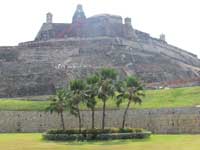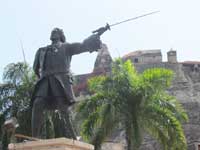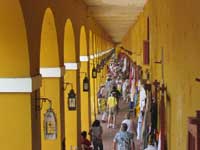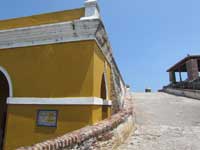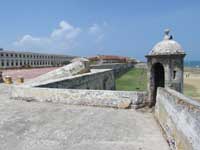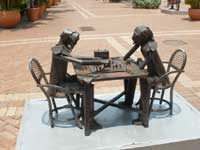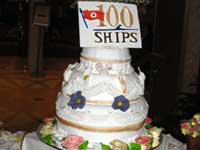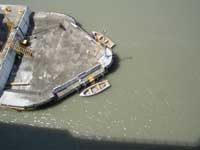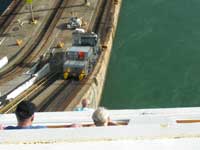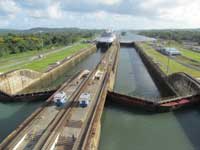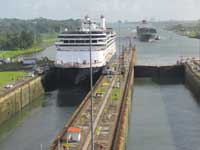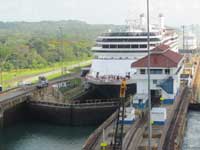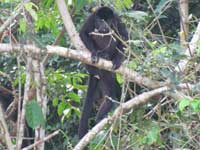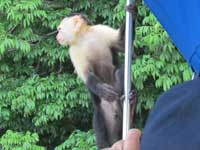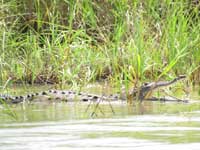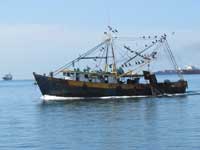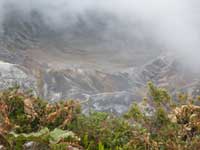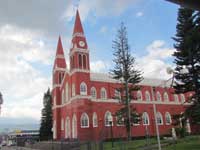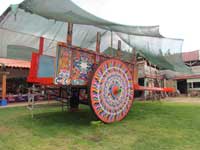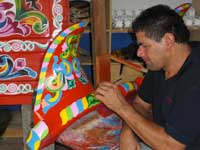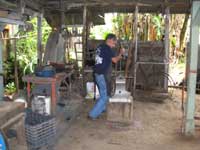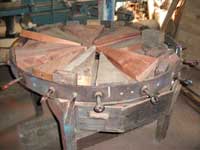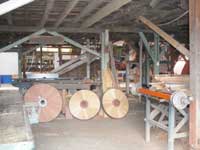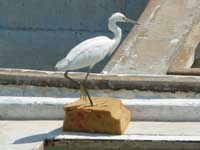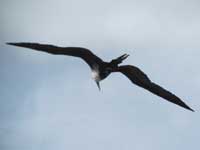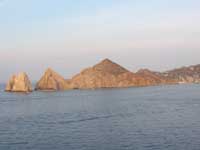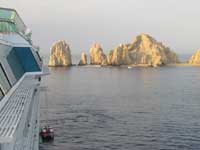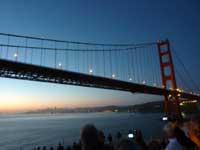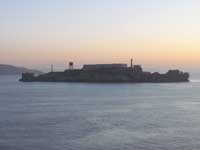From Fort Lauderdale to San Francisco through the Panama Canal in April 2011 on Sea Princess
Panama Canal (download 850KB PDF file) | Map
Panama Canal
A long journey to Los Angeles and onward to Fort Lauderdale in Florida eventually got us to the good ship 'Sea Princess' for our cruise to Central America and California, the highlight of which would be the traversing of the Panama Canal. The embarkation was swift and painless; it is a distinct advantage that our many voyages with Princess Cruises have earned us sufficient loyalty points to be awarded 'VIP' status and along with it, priority boarding and streamlined formalities.
Having set sail from Ft. Lauderdale en route to Aruba in the Caribbean, we were somewhat perplexed at about 10.30pm, to see the lights of what was obviously a large conurbation on our port side. Having failed to find any such feature on the charts, we asked the Purser where we were and she gaily informed us we were almost back to Ft. Lauderdale as there was a medical emergency and the affected passenger had to be off-loaded but that the captain would be able to make up the lost time and we should be in Aruba on schedule. Sure enough, a few minutes later we were back at the dockside which was swarming with police (why them?), medical personnel and an ambulance. Within 20 minutes or so the transfer had been completed and we were off again.
Next morning, the captain made an announcement telling those who had slept through it all what had happened and assuring us we would be in Aruba as planned. Yeah, right! As they say here in New Zealand. About two hours later we were told that there was another emergency and that we were heading back to Florida again and would be delayed while rendezvousing with a coastguard helicopter which had been summoned to remove the patient. Needless to say, this additional delay did cost us the call at Aruba, which was disappointing but abandoned calls for one reason or another are one of the possible pitfalls of cruising. Anyone who read our Alaska travelogue will remember we had a similar experience with a helicopter evacuation - is it something about us?
Cartagena, Columbia
An extra day at sea meant more time to meet new people and catch up on reading and relaxation. We duly arrived in Cartagena, Colombia, where we had booked an excursion as we were unsure of the wisdom of wandering alone in the home of the drug cartels! We had a very interesting and enjoyable day and the tour was well worth while as we saw lots of places we would never have known about otherwise. Columbia is apparently much 'cleaner' than a few years ago, the cartels having apparently moved to Mexico, and we actually didn't feel at all nervous but we were still glad we had taken the tour because some people who went independently didn't see nearly as much and also said they were bothered by touts the whole time, which we would have hated. There were plenty of them about but we just said no thank you and they left us alone; we assume that they know the tour guides have told us not to buy from them (most of the goods are fakes - especially the 'silver' and 'Cuban' cigars!).
There are some beautiful old buildings and we were able to visit one of the most striking, the Nuñez Villa, which was once the home of the president. It had been furnished and equipped in the style of the times and so gave an interesting insight into their domestic arrangements. The gardens were beautiful and featured three very tame, colourful parrots who revelled in having their photographs taken - and who could resist capturing such glorious plumage?
The Coffee Association headquarters next door to the villa and also the church just across the road, in its own park, together made for a very attractive and genteel enclave of the city. More forbidding, and more telling of its earlier history, however, were the massive walls and huge castle fortress dominating the city, as you see from the photographs.
Cartagena was one of the main centres of the Conquistadors and also the Spanish Inquisition. A visit to the museum illustrated that its history had not been a happy one and the torture chambers exhibits, in particular, made our blood run cold. It was not all doom and gloom, however, and a tour of the gold museum cheered us up and left us drooling at the richness on display - though it has to be said that the gold bra did not look terribly comfortable!
The tour included a visit to the arcade of souvenir shops situated in the old prison cells at the foot of the massive, fortified walls. We resisted the shopping opportunity and instead, took a walk on the path atop the walls, which is as wide as a road (though no cars are actually allowed to drive on them).
The final stop of the tour was at the inevitable emerald shop - we had chosen this particular tour partly because it only featured one such emporium rather than an entire, two-story shopping centre full of them which was offered with most of the trips. We had no desire to shop for emeralds and the guide and owner of the shop were most surprised when we declined the 'bribe' of free beer if we went in to “just have a look”; on being quizzed as to why we didn't want to join the rest of the party Sarah simply replied that she didn't like emeralds, which was clearly an excuse they had not heard before and worked like a charm. We then spent a pleasant half hour exploring the pretty streets of the area and a town square full of witty, metal, sculptures until it was time to rejoin the group for the drive back to the ship.
The day we were in Cartagena was a special one as it was the day of the Royal Wedding and, more importantly, Martin's 65th birthday. Princess Lines made a big celebration of it (the wedding that is) and there was a continual broadcast of all the festivities on the outdoor movie screen all day and into the evening. I must confess we did not rise at 4am to watch all the coverage but did see the actual wedding. Martin said it was nice of London to put out all those flags in his honour.
In addition to all that excitement, on that day, April 29th, Carnival, the company which owns Princess Cruises, took delivery of its 100th ship and now has the biggest fleet in the world. All their ships around the world celebrated the day with a huge wedding-style cake and balloons etc. for a total of 277,000 passengers + about 200,000 crew members. Everyone had a glass of champagne for toasting Kate and William and also the milestone of a 100-strong fleet.
Although it wasn't a designated formal night, most people had dressed up a bit, which was all very nice and one of the things we like about cruises and the people who take them.
In the evening there was a huge 'British' party and lots of old pub favourites were sung, increasingly raucously as the night wore on. There were about 1000 Brits on board and, regrettably, a large number of them were the sort for whom a 'knees up' of this sort was an excuse for thoroughly rowdy behaviour (decidedly not typical of our usual cruise companions). We were grateful that we were able to claim our 'Kiwi' identity!
Panama
The next day brought us to the real purpose of the voyage, traversing Panama Canal. We entered the approach channel at Colon, just after dawn, to begin the 80km journey from the Caribbean Sea to the Pacific Ocean. After about an hour we approached Gatun Locks, a flight of three locks forming a 'staircase' which would raise us up to Gatun Lake which is 26m above sea level. The lake is fed by the Chagres River and in turn it feeds the locks, entirely by gravity. Slow steaming across the lake, crossing the Continental Divide and through the narrow Culebra Cut, eventually brought us to Pedro Miguel Lock which was the first to start the process of lowering us back to sea level on the Pacific Ocean side. Leaving Pedro Miguel Lock, we entered Miraflores Lake and finally the two Miraflores Locks into a long inlet which let us out, under the Bridge of the Americas, into the Pacific Ocean, where we moored overnight off the resort island of Fuente Amador. By the time we reached this point the sun was setting and the brilliant colours threw into silhouette the skyscraper-skyline of Panama City. After the tranquillity and beauty of the lakes with their unspoilt jungle scenery, it came as quite a surprise, almost an intrusion, to find such a modern city so close at hand.
When passing through the locks, we were amazed to see that our ship only just fitted, with a scant 30cm clearance either side. Eight large, electric engines on rails beside the locks are attached to hawsers, which are run from the ships by men in small rowing boats. With all the modern technology that is available nowadays, this is apparently still the fastest and safest way to do it. Although the ships are actually running under their own power, the very skilled operators of the engines constantly adjust the length of the hawsers in order to keep the ships centralised. It is a matter of pride that the ship should escape unscathed, but equally, it is no real disgrace and taken almost as a badge of honour (and evidence of the traverse) when the odd black smear appears on the hull of a gleaming white ship.
Ours was one of the largest Panamax rated vessels, which means that its dimensions fit within the locks - if only just! These photos of the cruise ship which followed ours through the locks show how tight it was; she is roughly the same size as the Sea Princess.
Because the latest cargo and cruise ships are getting bigger all the time (some cruise ships now take 6000 passengers!) new locks are being constructed which will not only take the bigger vessels but will also employ new pumping, water storage and circulation technology. This will mean that the millions of gallons of water currently drained from the lake every time the locks operate will no longer be lost to the ocean and that the levels can be kept constant, regardless of the season.
We had decided that we would rather see more of the lakes and locks than explore the city so the next morning we joined an excursion party. The bus ride across the causeway linking the island to the mainland and Lake Gatun gave us an interesting view of local towns and villages as well as glimpses of the big ships sailing through the jungle, or so it seemed; we had not realised how close we were to the water. We boarded small motor craft and, in the experienced hands of our driver and guide, a qualified zoologist and botanist, set off to see what we could find. It was not long before we pulled into a creek as the driver had spotted some commotion in the trees. This turned out to be a colony of Howler monkeys swinging from branch to branch. They have a very selective diet and are only to be found where their particular favourite leaves and fruits are to be found. Once they had seen enough of us and gone on their way, we were taken to another inlet where a large number of cheeky Capuchin monkeys came to greet the boat (and a couple of others which had followed us). These monkeys have a very wide and varied diet - in fact they'll eat anything and are very greedy. The guide told us that one of the other tour operators, contrary to the rules of good environmental stewardship, made a habit of feeding these monkeys, hence their fearlessness in approaching humans. They clambered over the boats and posed for photographs, entertaining us all for quite a while.
A few minutes pottering around the edges of the lake allowed us to spot turtles, some the size of dinner plates and one the size of a coffee table, and many, many varieties of birds as well as various exotic trees, shrubs and flowers. Suddenly the driver turned the boat around and sped off towards a small, sandy beach area. After a few moments we saw what he had spotted - a basking crocodile, with his jaws wide open; soon another two slid into view, looking just like the proverbial tree trunks. We had been told that we might be lucky enough to spot one or two but never really expected to do so and certainly not this close. What a thrill!
Before returning to the ship, we were taken to the Visitor Centre, where we saw an informative film about the history of the Canal and its construction. The sheer enormity of the task of excavation, all done with picks and shovels, takes ones breath away and our admiration for both the 17th century Spanish visionary who first conceived the project and the engineers who saw it through, knows no bounds. Naturally, the sacrifices of those poor labourers for whom the task was too much cannot go unremarked and we were touched to see the beautiful bronze memorial which has been erected in memory of those who perished; sadly, this was on the side of a building, behind a locked gate, so we were unable to get close enough to photograph it. There was an excellent guest lecturer on board and he had told us a great deal but seeing the film certainly added a dimension to our understanding. Some of the footage was very old, taken around 1910 to1914, when the project was finally completed. We then went onto the viewing platform where we were able to gain an appreciation of the size of the locks and also the vast amount of water needed to fill them.
Puntarenas, Costa Rica
Our next port-of-call was Puntarenas in Costa Rica. This was another port where we had booked a tour as we were uncertain what independent shore arrangements could be made and we particularly wanted to visit Poas Volcano, which was about a two hour drive from the port. The drive to the volcano took us through a number of villages, coffee plantations and lovely countryside and our informative guide ensured that we gained a good insight into the country, its flora and fauna and also the way people lived from both a political and domestic perspective. We were particularly interested to learn that Costa Rica is one of only two countries recognized globally to lead the world in ecological sustainability, the other being New Zealand. We were intrigued to notice that the native flora is almost identical to ours and the farming emphases were also similar. It is one of the most stable, best educated and economically sound countries in Central America and this was evident in the beautifully kept houses, churches, parks and gardens found in almost every settlement.
Once we reached the volcano, the beautiful warm sunny weather we had enjoyed on the drive up deserted us and heavy clouds rolled in, completely concealing the turquoise lake in the caldera; the temperature also dropped several degrees and we were glad we had heeded the advice to take sweaters and jackets. Fortunately, it did not actually rain and a light breeze sprang up so the clouds did swirl around and occasionally clear enough for us to see the lake (grey, not turquoise that day) and the barren but colourful 'lunar' landscape.
After visiting the volcano we were taken to a delightful restaurant for lunch where we had a feast of local specialities including a drink of crushed strawberries, diluted with a little water. It was most refreshing and quite delicious. Strawberries are not native to Costa Rica but grow well there and have become a staple crop as well as a significant part of their diet when in season. Of course, we ended the meal with a cup of the fine coffee for which Costa Rica is justly famous. From the restaurant it was a short drive to our next stop, a bullock cart factory, via a town whose church is possibly the first example of recycling, being made almost entirely of metal taken from the hulls of trading ships which had ended their days in Costa Rica.
The bullock cart factory was not something which we had placed very high on our list of must-sees but in actual fact, it was definitely the highlight of the day. The highly decorated carts were traditionally used by farmers at the market but have now become something of a folk artefact and are sold mainly to tourists (in their miniature version) or companies and restaurants for decoration. A very large one was being refurbished and it was a pleasure to see the artisans at work. Wheelwrights, blacksmiths and painters all working by hand in time-honoured fashion made for a fascinating visit and an appreciation that these skills have not been lost to the modern generation.
Cabo San Luca, Mexico
Three more relaxing days at sea, with perfect weather, gave us ample opportunity to relax and also use the swimming pool and Jacuzzis before we arrived at Cabo San Lucas, Mexico. This is now one of the few ports in Mexico that most cruise lines will visit, due to the aforementioned shift in the drug trade, and attendant criminal activities. It seems to exist purely for the wealthy, mainly American, yachting and boating crowd and some of the craft to be seen in the harbour were quite breathtaking - especially the one with its own helicopter on the aft deck!
There are some very attractive rock formations and beaches at the entrance to the harbour but once these have been admired, it seemed to us that the town existed solely for the purpose of getting visitors drunk, overfed and impoverished by any of the dozens of bars, restaurants and jewellery shops which made up the bulk of the town's businesses. There was a particularly garish souvenir 'market' behind which, however, we found a delightful, old and traditionally decorated and run coffee shop where we enjoyed an excellent cup of coffee in the company of some ship-mates who shared our opinion of the town and what it had to offer. We went back to the ship in time for lunch and spent a peaceful afternoon on our balcony and on deck, watching the movements of the many boats and antics of the pelicans and frigate birds. As she was walking around the deck, Sarah even spotted a whale spouting and breaching but unfortunately it did not stay around long enough for her to let Martin know about it in time to see it too.
That evening we sailed away at sunset, admiring the beautiful display of colours in the sky. Sadly, it was the last we were to see of the sun until we arrived at San Francisco two days later.
California
It was a thrill to glide under the Golden Gate Bridge just as the sun rose, then past the evocative prison island of Alcatraz and onto our pier ready for disembarkation. The only small thing which spoiled our arrival was the necessity to queue for over an hour in order to spend 30 seconds with a US Immigration Service Officer. We had been given timed appointments but this system was clearly not being enforced and the resulting crowding just slowed everything down and caused delays. Our VIP status was no help on this occasion, alas!
We were a couple of hours later getting off the ship than we had anticipated which was a nuisance as we had a lunch date with friends in San Jose (about an hour's drive away). Fortunately we were able to let them know we were delayed and in the event, thanks to efficient car hire personnel and our GPS navigator, we still got to them in reasonable time. It was lovely to catch up with Jack and Elaine, whom we had met in a hotel in Tahiti when we were about to embark on one of our Tahitian Princess cruises; it turned out they were on the same ship and we have been firm friends ever since.
Sadly, we were not able to stay longer in San Jose but left the next morning for the drive, via the Gold Country route, to Granite Bay near Sacramento, where we spent three nights with friends, Kathy and Rod, whom we met on our first ever cruise, in the Caribbean in January 1985! After a wonderful time visiting too many wineries, sampling too many wines and eating far too much good food, we left them drove back to San Francisco for flight home.
It was lovely to see the family again and after dinner at their house on our first night back, we quickly settled into life at home - and we are now on strict diets, both having put on a couple of kilos round the middle during our trip, most of them gained during the four days in California!
Panama Canal (download 850KB PDF file) | Map

